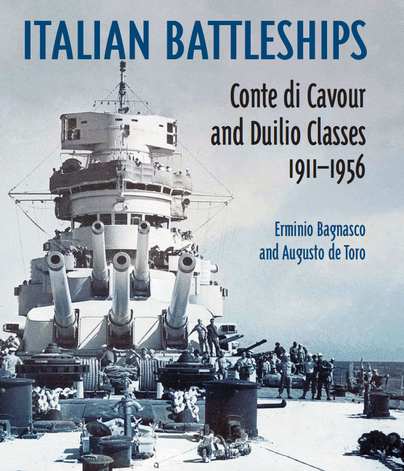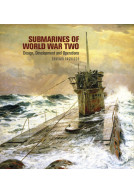Italian Battleships (Hardback)
'Conte di Cavour' & 'Duilio' Classes 1911-1956
Review!
Video review by Dr Alexander Clarke
(click here for international delivery rates)
Need a currency converter? Check XE.com for live rates
| Other formats available | Price |
|---|---|
| Italian Battleships ePub (81.8 MB) Add to Basket | £19.99 |
With the publication of their previous book on the battleships of the Littorio class, the authors set new standards for the detailed coverage and sophisticated analysis of Italian warship design. Inspired by its success, both critically and commercially, the authors were inspired to follow up with a similar study of the earlier Italian battleships that were built in the First World War but survived to fight in the Second. Given the level of new research required, this has taken a decade to achieve but the result is a similarly comprehensive coverage.
Originally comprising five ships in two related classes, they entered service at the beginning of the Great War. As designed, they were powerful examples of the second generation of dreadnoughts, with a combination of twin and triple turrets producing a unique main armament of thirteen 12-inch guns. One ship, Leonardo da Vinci, was sunk by an internal explosion at Taranto in 1916, and although the hull was raised post-war, the plan to rebuild the ship was abandoned as it was not deemed cost-effective.
However, the remaining four ships were to undergo one of the most radical reconstructions of any battleship class during the 1930s, emerging with an entirely new profile, more powerful machinery and all the characteristics of a modern fast battleship. In this form they became an important element in the Italian fleet that opposed the British after 1940. This book covers all the technical details of the ships, both as built and as rebuilt, but also provides an extended history of their active service, including battle plans and track charts.
Thoroughly illustrated with photographs, ship and armament plans, detail drawings and colour camouflage schemes, the book is a fitting companion to The Littorio Class.
Italian Battleships is a welcome addition to the historiography of the Regia Marina’s surface fleet, and an excellent English language research tool for both Italian battleship construction and their performance during the Second World War, the latter topic often overshadowed by the more familiar Kreigsmarine. Bagnasco and de Toro do a solid job of documenting the now-extinct Conte di Cavour and Duilio classes, managing to pack a surprisingly large amount of technical and chronological data into the 267 main pages of text. Their work is definitely a welcome addition to both English and Italian language scholarship on the subject, especially for those researching the Mediterranean theatre of the Second World War.
The Northern Mariner/Le marin du nord (Vol. 33, Nos 3 and 4).
"this is an essential reference for these ships, with comprehensive data and superlative illustration. It is an excellent complement to the book on the battleships of the Littorio class (Seaforth 2011) by the same authors."
Warship Annual - 2023
The book goes into great detail about the Italian Navy’s operations during World War Two which was very interesting. There’s an interesting account of the loss of Giulio Cesare in Russian hands in 1956: one of many Battleships lost to an internal magazine explosion (two of these five included) with the usual terrible casualty list - 609 dead. Near the end of the book there is a short but interesting colour section and a long listing of every movement of the four surviving ships during WW2.
Warship World Magazine
This book is clearly a labour of love by the authors who have poured huge amounts of time and effort into crafting it. There is a wealth of stunning photographs (mostly black and white) and for model boat enthusiasts the line drawings are plentiful and extremely detailed.
I would say that readers will appreciate the exceptional thoroughness of the authors’ research and how it is utilized. In addition, they will be rewarded with a very interesting explanation of Italian naval headaches during World War II. This book is educational, entertaining and therefore a must for naval history buffs.
Nautical Research Journal
The book, ably translated from its original Italian, benefits greatly from being written from an Italian perspective. This gives considerable authenticity to many of the insights and observations made by the authors, one of whom is a former senior officer in the Italian Navy. This well-researched book, supported by a large number of black and white photographs, is a definitive ‘warts and all’ history of an important chapter in the history of Italian battleships.
The Naval Review
Read the full review here
The book is highly illustrated throughout, with hundreds of archive images from all periods of their service, along with many detailed drawings and diagrams which include the description of all the many ships spaces. Especially attractive for modellers, there is also a section of colour profiles, illustrating the varied colour schemes they carried over their service careers. Everything is provided in great detail and I can't imagine there can be anything else to add, and supported by so many excellent images. Highly recommended.
Military Model Scene
Read the full review here
Thoroughly illustrated with photographs, ship and armament plans, detail drawings and colour camouflage schemes, the book is a fitting companion to The Littorio Class.
UK Historian
This is a beautiful book inside and out looking at Italian battleships from beginning to end featuring two classes of Italian ship, the Conte di Cavour and the Duilio. This book covers from the 1910’s to the 50’s and the book is absolutely packed with many excellent photographs, diagrams, charts and statistical information. This book is one of those books that becomes a goto resource for any information you need on the subject, the research and writing is very good and has been painstakingly done, it really is so comprehensively made. I would more than happily recommend this book to anyone with an interest in naval ships and design.
Read the full review here
Italian battleships from my experience do not get much in the way of cover, and so this offering from Seaforth Publishing provides the reader with a good look at how vessels from the first war were brought up together to take part in the second. The combination of the written word, schematics, photographs and artists prints all in one place provides a concise look at these battleship classes.
Armorama
Read the full review here
Click here to watch
Video review by Dr Alexander Clarke
This a further collaboration of two authors who previously crafted a similar book on the Littorio Class battleships. The vessels are covered impressively by this book, the survivors of a class designed before WWI – Very Highly Recommended
Firetrench
Read the full review here
Featured in
Storia Militare - August 2021
This is the story of the ships of two classes of Italian battleships, Conte di Cavour and Duilio Classes from their beginnings to their ends. The design decisions which brought them into being, the building processes, their wartime activities and the finale of the breakers yards are all here. The period covered is from 1911 to 1956. The book is packed with information which could only have been gathered and presented through painstaking research by the two authors. The text is clear and lucid and is supported by an incredible number of photographs of all aspects of the ships’ existence. Even the various camouflage designs and colours are illustrated. There cannot be much to be known about these vessels, as individual ships that is not in this book.
Clash of Steel
It is a pleasure to read and we warmly recommend it to a wide range of readers.
Read the full review here
"This book is an absorbing read. It is a book that anybody with an interest in Italian battleships should read."
Les Brown, Small Warships
This excellent book covers all aspects of these long lived ships, from their initial design, through their use in peace and war, continuing into the early 1950s. The book examines Italian politics and foreign policy within the Mediterranean to place the design in context and explain why the ships were inferior to many other ships of the same period. The extensive modernisation programme is looked at in great detail, and again this is used to inform Italian naval policy from the late 1930s and through the war years.
Nigel Denchfield, IPMS Battleship Group.
The drawings and plans are many, and beautifully drawn by Roberto Maggi and Maurizio Brescia. The photographs used are a joy to see, and those featuring the internal spaces of the ships are fascinating and add the final gloss to the detail achieved by the book.
Operations carried out by the ships are written about with painstaking detail, and these accounts do not shy away from negative analysis of decisions made by senior officers at command level, both ashore and at sea.
This book will be of great interest to historians and modellers.
If your interest is in Italian Dreadnoughts / Battleships of all periods, then the book provides excellent value for money. Highly Recommended.
Cher Ami, Great War Sig Newsletter - IPMS, June 2021
"For anyone with an interest in Warship design especially capital ships, or Italian naval history, this volume comes highly recommended, essential for all those with an interest in naval history."
Martin Willoughby, Chairman of the Wessex Branch of the Western Front Association
About Erminio Bagnasco
ERMINIO BAGNASCO is the Editor of Storia Militare, Italy’s leading military journal. He is the author of many books on Italian warships, and is widely regarded as the foremost authority. As for Littorio Class, he was assisted by AUGUSTO DE TORO, an authority on the political and economic aspects of naval policy, and himself the author of many articles and monographs.
About Augusto De Toro
AUGUSTO DE TORO is an authority on the political and economic aspects of naval policy, and himself the author of many articles and monographs, including co-writing The Littorio Class and Italian Battleships.
The Littorio Class Italy's Last and Largest Battleships (Hardback)
For its final battleship design Italy ignored all treaty restrictions on tonnage, and produced one of Europe's largest and most powerful capital ships, comparable with Germany's Bismarck class, similarly built in defiance of international agreements. The three ships of the Littorio class were typical of Italian design, being fast and elegant, but also boasting a revolutionary protective scheme – which was tested to the limits, as all three were to be heavily damaged in the hard-fought naval war in the Mediterranean; Roma had the unfortunate distinction of being the first capital ship sunk by…
By Erminio BagnascoClick here to buy both titles for £90.00




















